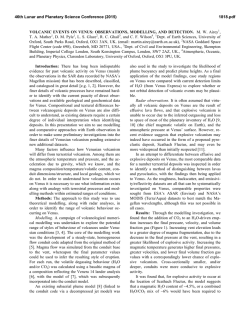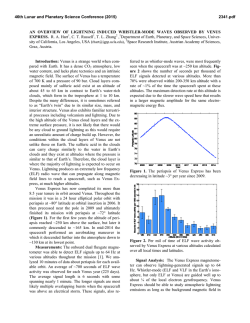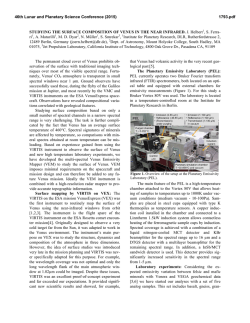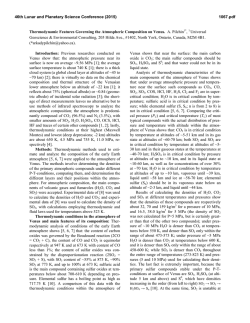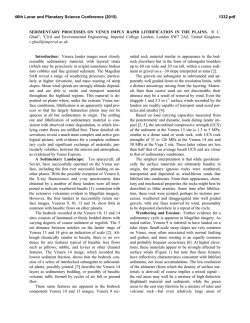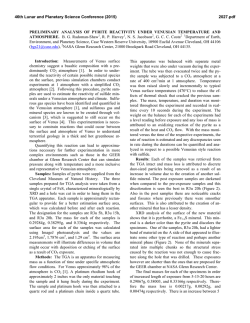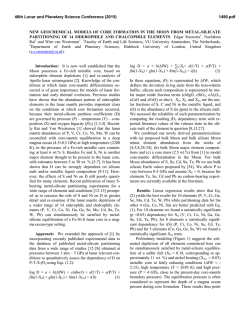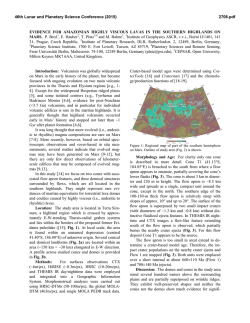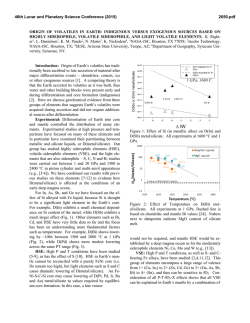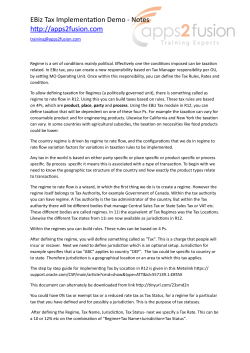
Bi-Stability, the Evolution of Terrestrial Planets and - USRA
46th Lunar and Planetary Science Conference (2015) 2670.pdf Diverging Worlds: Bi-Stability, The Evolution of Terrestrial Planets and Its Application to Venus and Earth. M. B. Weller1 and A. Lenardic1, 1Department of Earth Science, Rice University, Houston, TX 77005, USA ([email protected], [email protected]). Introduction: A key observation and open question in the Earth and Planetary Sciences is that the Earth is seemingly unique in that it exhibits plate tectonics and a buffered climate allowing liquid water to exist at the surface over its geologic lifetime. While we know plate tectonics is currently in operation on the Earth, both the timing of its onset and the length of its activity are far from certain. Uncertainty about the initiation of plate tectonics, and the initial lid-state for the Earth has been extended to extra-solar terrestrial planets and ‘Super-Earths’, with several groups arguing that a stagnant-lid regime should be favored [1– 3], while others argue that mobile-lid style of convection will dominate [4–7]. In order to understand the potential for plate tectonics on far flung extra-solar planets (both more and less massive than the Earth), the evolution of early planets, and the apparent divergence in the evolution of Earth and Venus needs to be explored. Observations of Venus’ current surface reveal a world that could not be more dissimilar than the Earth. The thick 92 bar Venusian atmosphere is comprised of 96.5% CO2 that has resulted in an extreme greenhouse climate, and a surface temperature ~740 K, ~450 K hotter than the surface of the Earth. Upwards of 80% of the surface of Venus is covered by vast volcanic plains, which are thought to have been emplaced in the last 300 -1000 Myr [8–10], perhaps ‘catastrophically’ [9, 10]. Currently, Venus shows no clear evidence of plate tectonic activity, suggesting that the planet is either within a stagnant-, or episodic-lid regime [11– 14], but may have exhibited some form of mobile-lid activity, perhaps locally, in the past [e.g. 15]. Here, we propose a self-consistent process of planetary evolution, incorporating system ageing (e.g. decreasing radiogenics), atmospheric evolution (e.g. temperature), and tectonic regime transitions to explain the divergence of Venus and Earth. Thermal Evolution and Bi-Stability: Growing evidence suggests that planets can transition between tectonic regimes over time. Recent studies have suggested that the early Earth operated under a stagnant to episodic-lid regime [e.g. 16, 17]. Further studies show that systems with high levels of internal heating strongly favor early (hot) stagnant-lid states [3, 18– 19]. As radiogenics are tapped, the lid yields through an intermediary (short-lived) episodic-lid, into a mobile-lid regime. Increasing surface temperatures, operating on geologic time scales, have also been shown to cause a transition from mobile-lid convection, into and through an episodic-lid regime, before eventually settling into stagnant-lid behavior [19–22]. In contrast to the intermediary episodic-lid associated with decreasing internal heating rates and low surface temperatures, episodic regimes associated with the effects of increasing surface temperatures indicate long-lived and robust episodic activity [19]. While convective systems have the ability to transition between tectonic regimes in time, a result of thermal evolution, the path of this evolution may be complex. Nonlinearities inherent in the convective system lead to a hysteresis of states in which multiple stable tectonic regimes are possible for the same planetary parameter values (or bi-stability) [19, 23–25]. The range in parameter space in which multiple stable solutions exists increases with increasing Rayleigh numbers or increasing viscosity contrasts [24]. Both factors are expected to increase for larger terrestrial planets, or increasingly energetic planets (such as early Earth or Venus). Within the bi-stability window, the tectonic regime of the system becomes a function of a planet's specific geologic and climatic history, indicating that two otherwise identical systems can exist in different states as a function of a small perturbation of the system within the bi-stability field. Taken together, these results suggest that transitions between tectonic regimes can occur at the same thermal time (e.g. temperature), but due to different evolutionary histories (internal heating), these regime shifts can occur at very different temporal times. A Case for the Divergence of Venus and Earth: The framework of bi-stability and evolutionary pathways offer insights into the apparent Earth/Venus paradox. Within this model, early planets are highly likely to operate within a stagnant-lid regime. All things being held equal, as the planetary systems age, and radiogenics decrease, it would be expected that the early stagnant-lids would yield first into a transitory episodic-lid near the same epoch, before settling into a more mature stage mobile-lid. Evidence suggests that this is perhaps the evolutionary track of the Earth [e.g. 16, 17, 26], but evidence for early lid transitions are difficult to determine for Venus, and current observations of the Venusian surface may challenge the timing of these often debated transitions (suggested at ~3 Ga for the Earth [27], and ~ 1 Ga for Venus [e.g. 9, 10]). One possible explanation for this discrepancy comes from the concept of bi-stability itself. Both systems 46th Lunar and Planetary Science Conference (2015) may have initially begun transitioning in the same epoch, but this transition occurs at a bifurcation point in their similar evolutionary paths. A small, random fluctuation in the internal dynamics of either system may have sent the planets in diverging directions, the Earth mobile and Venus (at least temporarily) stagnant. Past the bifurcation point, the thermal state of the respective lid can act to self-reinforce (through the exponential dependence of viscosity on temperature, and consequently convective stress [e.g. 20, 24]). Eventually, in the case of Venus, radiogenics may decrease further and allow for the yielding of a now longer-lived, more thermally mature (e.g. cooler) stagnant-lid. As a result an episodic Venus may have emerged at a later interval of time. While this result is possible, it is for all intents and purposes due to random fluctuations in the system, and the timing of transitions are by nature, nonpredictive. We offer a second explanation for this discrepancy that comes from recent work, where it has been suggested that the bulk silicate composition of the Earth may be nonchondritic, with a 30 – 50% reduction in heat producing elements [28]. A reduction of radiogenic heat input of ~1/3 to ~1/2 results in a decrease of internal temperature of ~ 24 – 41%, respectively, following well established internal heating scaling laws [e.g. 29 – 31]. Lower initial internal heating rates for the early Earth result in lower internal temperatures (more mature thermal evolution) relative to Venus, which act to alter transition times in absolute ages. Accounting for a nonchondritic Earth, a near chondritic Venus, and a change in lid regimes for the Earth at ~ 3 Ga suggest that an otherwise comparable Venus should begin to transition out of a stagnant-lid and into an episodic-lid at ~ 2.2 – 1.6 Ga. A longer lived stagnant-lid may have profound implications for the current state of Venus, stagnant-lids tend to favor the suppression of a thermally driven core dynamo, and can allow for a longer build up of volcanic products (e.g. CO2) without significant volatile cycling into the interior. The longer build-up time of greenhouse gases (e.g. higher surface temperature), coupled with higher internal temperatures due to higher radiogenic abundances (or a longer stagnant-lid state), in addition to increased proximity to, and increasing Solar luminosity may have set the stage for current Venus. Path to Current Venus and Earth: While both planets may have evolved along a similar initial pathway (e.g. an initial stagnant-lid), either due to a random perturbation, or decreased internal heating of the Earth, Venus remained within a stagnant-lid state for a longer period of time. For Venus, over an additional ~ 1 – 2 Gyr, volcanic processes continually emit greenhouse gases, Solar luminosity increases, and as a result 2670.pdf surface temperatures also increase. As Venusian radiogenics decrease, internal temperatures drop, and Venus enter an episodic regime. In contrast to an early episodic transition, the onset of this episodic-lid occurs in a higher surface temperature regime, which implies long-lived and extensive overturn events [19]. These overturns initiate rapid and significant pulses of melt that release large quantities of volatiles and greenhouse gases into the atmosphere. The rapid influx of greenhouse gases ensures surface temperatures increase dramatically, forcing the transitioning Venus firmly into a high surface temperature tectonic regime (episodic or stagnant-lid) [e.g. 19 –22], resulting in the Venus we see today. It is important to state that either random fluctuations in an early simultaneous episodiclid from bi-stability theory, or decreased internal heating rates for the Earth (effectively ‘ageing’ the Earth relative to Venus) exhibit very similar pathways and predictions, neither can be unambiguously determined with the data currently at our disposal, so either explanation is equally valid at present (and both may have played a role). References: [1] O’Neill and Lenardic (2007), GRL, 34, L19204; [2] Stein et al., (2011), GRL, 38, L21201; [3] Stein et al. (2013), EPSL, 361, 448-459; [4] Valenica et al. (2007), Astrophys. J., 670, L45 ; [5] Valenica & O’Connell (2009), EPSL., 286, 492–502; [6] van Heck and Tackley (2011), EPSL., 310, 252–261; [7] Tackley et al. (2013), Icarus, 225, 1, 50-61; [8] McKinnon et al. (1997) , Venus II. Arizona Univ. Press, pp. 969–1014; [9] Schaber, et al. (1992), JGR, 97, 13257–13301 ; [10] Strom et al. (1994) , 99, JGR 10899– 10926; [11] Schubert et al. (1997), Venus II. pp. 1245–12888 ; [12] Nimmo and McKenzie (1998), Annu. Rev. Earth Planet. Sci. 26, 23–51 ; [13] Moresi, L. and Solomatov, V. (1998), JGR, 133, 669-682 ; [14] Stein et al., (2011), GRL, 37, L01201; [15] Kiefer, LPSC 44, # 2541; [16] Debaille et al (2013), EPSL, 373, 83–92; [17] O'Neill & Debaille (2014), EPSL, 406, 49-58; [18] O’Neill, et al. (in review), GJI; [19] Weller et al. (accepted), EPSL; [20] Lenardic et al. (2008), EPSL, 271, 34-42; [21] Landuyt & Bercovici (2009), EPSL, 277, 29-37; [22] Foley, et al. (2012), EPSL 331, 281– 290;[23] Crowley & O’Connell (2012), GJI, 188, 61–78; [24] Weller & Lenardic (2012), GRL, 39, L10202; [25] Lenardic & Crowley (2012), APJ, 755.2:132; [26] O’Neill et al. (2007), EPSL 262, 552-562 ; [27] Shirey & Richardson (2011), Science, 333, 434–436. [28] Jackson & Jellinek (2013), G3, 14,8; [29] Sotin & Labrosse (1999), PEPI, 112(3– 4), 171–190; [30] Moore (2008), JGR, 113, B11407; [31] Weller et al. (in prep).
© Copyright 2026
